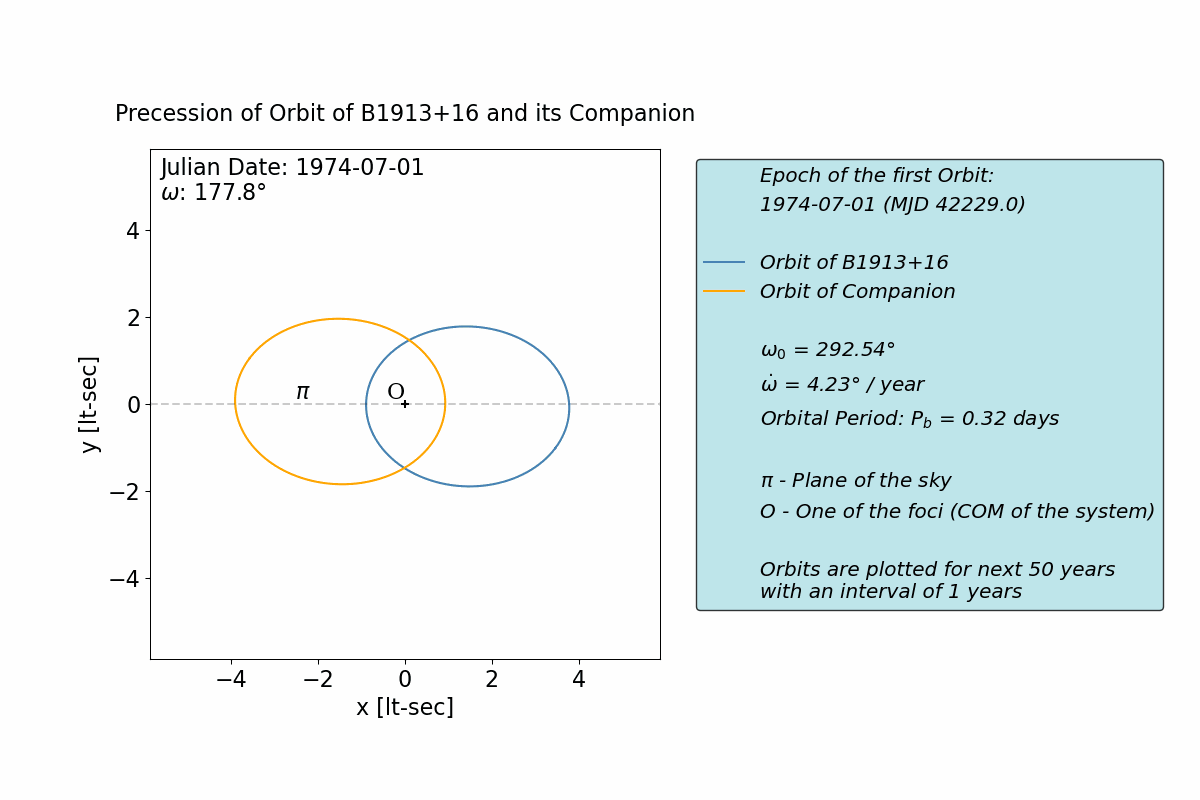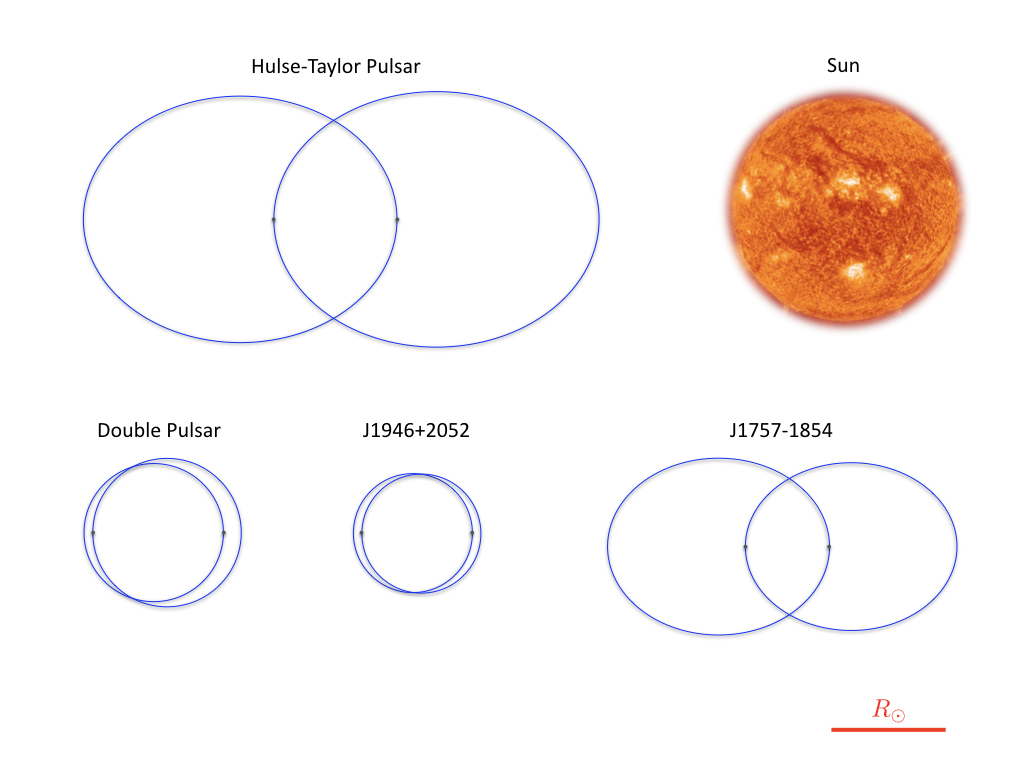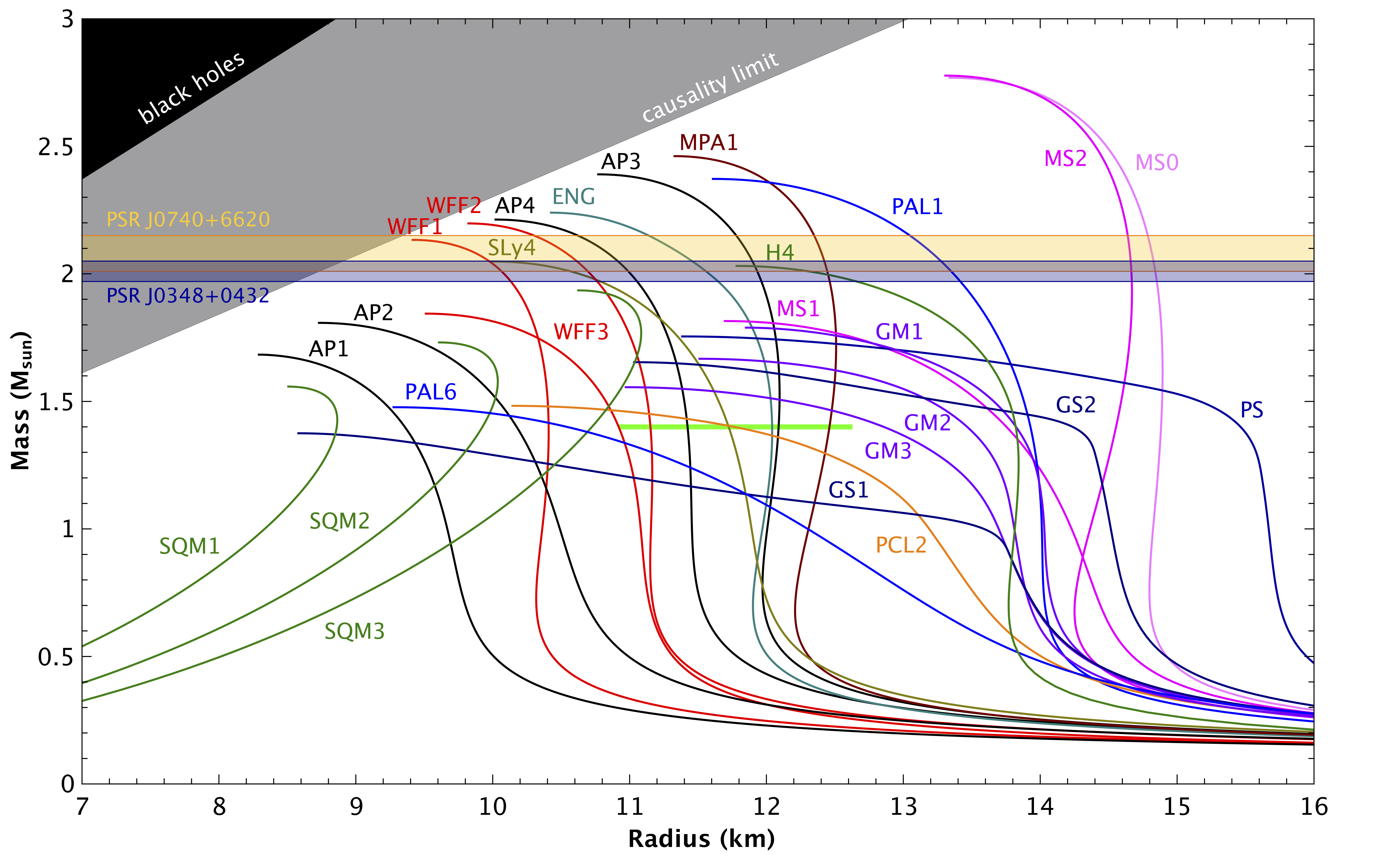Research Interests: Binary Pulsars!
What are binary pulsars? and... Why?
When the cores of massive stars run out of nuclear fuel they collapse catastrophically - a supernova. This compresses the core material so hard that even its atoms are destroyed, forming an incredibly dense ball of neutrons: a neutron star (henceforth NS).

Figure 1: The Crab Nebula is the remnant of a supernova that occurred in the constellation Taurus in
the year 1054 AD (as seen from Earth). Credit: HST/NASA/ESA.
Recycled radio pulsars possess extraordinary long-term rotational stability. Timing their radio pulses, we can determine their spin periods, spin-down rate, position and proper motion with spectacular accuracy.
Because of their formation, most recycled pulsars are found in binary systems. In these cases, radio pulsar timing allows astoundingly precise measurements of the pulsar's orbital motion.
Most of the companions to recycled pulsars are also compact objects: other NSs or white dwarfs. This means that the components behave as point masses. This has a fundamental consequence: the small relativistic perturbations to the orbital motion predicted by general relativity (GR) are not mixed with any Newtonian effects caused by tides or the rotation of the companion. The precision of pulsar timing is such that some of these relativistic perturbations are measurable, in some binaries to very high precision. We thus have not only a very precise experiment, but an extremely clean one as well.
In this review, Norbert Wex and I summarise the most important GR tests with radio pulsars to date, some of these are mentioned below.
The Hulse-Taylor binary pulsar
The best known example of what can be achieved by timing binary pulsars is the study of the first binary pulsar, PSR B1913+16. The system was discovered in 1974 by Russel Hulse and Joseph Taylor using the Arecibo radio telescope. With a spin period of 59 ms, the pulsar is recycled, its companion is another NS, and the orbit is very tight (its period is 7 hours and 45 minutes) and eccentric (e = 0.61).In this system, three relativistic effects on the orbit were measured from the pulsar timing. The first two (the advance of periastron and the Einstein delay) were used to determine the masses of the two NSs assuming GR. The third relativistic effect, a decrease of the pulsar's orbital period, matches exactly the GR prediction for the orbital decay for this system caused by the emission of gravitational waves!

Figure 2: Orbital precession for PSR B1913+16, with the orbital orientation for the pulsar and
companion plotted for the first 50 years after the discovery. The direction to the Earth is
down the y axis. Credit: Paulo Freire/ Sanket Bangar.
This measurement achieved two goals that cannot be achieved by Solar System experiments: First, it confirmed the self-consistency of GR for strongly gravitating objects. But, more importantly, it confirmed experimentally the physical reality of gravitational waves (GWs) - they indeed carry energy across space as predicted by GR. This indirect detection of GWs happened decades before LIGO.
Because of the importance of their discovery, Russel Hulse and Joe Taylor were awarded the Nobel Prize in Physics in 1993.
The promise of gravitational wave astronomy
This is a supremely important discovery since GWs are not merely another relativistic effect which we can use to test GR. They are messengers that carry information across vast distances. That means that if we build an extremely sensitive GW detector, we can in principle detect faraway objects by listening to the gravitational waves they emit.Would such a detector really hear anything at all? This is where the full importance of the discovery of PSR B1913+16 becomes clear. The orbital decay of the system implies that it will continuously lose orbital energy, with the two neutron stars inevitably merging in 300 million years. At that time they will emit a gigantic GW burst. If we observe several double NS systems in our Galaxy, there must be many, many other such systems in the Universe, with many of them merging in any particular year. This means that a sufficiently sensitive detector should certainly hear many such mergers. This process is so prevalent in the Universe that it is actually though to originate most of the heavy elements in the periodic table, like gold, platinum, lead and uranium!
It is because of this certainty that LIGO and Virgo could be built. LIGO's detection of the merger of two 30-solar mass black holes in 2015 opened up a new window on the Universe. The detection of GW170817, which was also seen throughout the electromagnetic spectrum, showed that the ground-based detectors are already sensitive enough to detect the mergers of double NS systems like PSR B1913+16.
Following the direct detection of gravitational waves with LIGO, Rainer Weiss, Barry Barish and Kip Thorne were awarded the Nobel Prize in Physics in 2017.
Research Projects
General relativity - the current, unsurpassed description of gravity - appears to be incompatible with quantum mechanics. Furthermore, it predicts its own failure at the centres of black holes; this means that it cannot be the ultimate description of gravity.More recently, alternative theories of gravity have been proposed to explain the rotational curves of galaxies and clusters of Galaxies without the need for Dark Matter, the accelerated expansion of the Universe without the need for Dark Energy and Cosmic Inflation (fundamental for understanding the origin of the Universe), which was driven by a still unknown force.
Is gravity really responsible for these phenomena, or are we in the presence of other forces of nature? Clearly, understanding it and testing it at all scales is important not only for understanding the laws of Nature, but also the origin, evolution and contents the Universe!
Another major puzzle arises from the unique properties of another fundamental interaction, the strong nuclear force. For densities higher than that of the atomic nucleus, the composition and behavior of nuclear matter is not known. This is a fundamental problem in nuclear physics, and in many areas of astrophysics.
Binary radio pulsars are fantastic laboratories to probe these phenomena: The extreme density of matter and the extreme gravitational fields of neutron stars mean that they probe our understanding of gravity and of nuclear forces. Timing these pulsars, we can answer some detailed questions:
- How precisely does GR describe gravity?
- Can we detect phenomena beyond GR?
- How massive can NSs be?
- Are there any millisecond pulsar - black hole binaries?
1. How precisely does GR describe gravity?
As mentioned above, pulsar experiments have tested GR with very high precision. Thus far, GR has passed all precise pulsar tests:- Timing the double pulsar
(PSR J0737−3039, discovered in the Parkes High Galactic Latitude
Survey) has yielded some of the most precise
strong-field tests of GR:
- These measurements include the most precise tests of the radiative properties of gravity: the measured orbital decay (−39.3770 ± 0.0025 microseconds per year, the uncertainty is a 68.3% confidence limit) agrees with the prediction of general relativity within the experimental precision of 0.0063%. This is 25 times more precise than for the Hulse-Taylor binary!
- They also include the detection, for the first time, of second-order effects in the Shapiro delay, one of them being light bending! This experiment probes the propagation of radiation in a spacetime with 106 times higher curvature than any non-pulsar experiment! Furthermore, the fact that this spacetime curvature is caused by a neutron star makes this experiment non-trivial.
- In addition, there are also important second-order effects on the periastron advance. One of these is the Lense-Thirring effect, the frame dragging caused by the rotation of pulsar A. The latter effect will, when measured more precisely, be important for measuring the moment of inertia of pulsar A.
- In 2017, we announced the discovery of a new extremely relativistic pulsar - NS system PSR J1757−1854, which has the most accelerated pulsar known. Updated parameters were published in 2023. This system is a great candidate for measuring the relativistic orbital deformation and the Lense-Thirring effect in a binary pulsar.
- In 2018, the PALFA survey consortium announced the discovery of a new extremely relativistic pulsar - NS system, PSR J1946+2052, with a record shortest orbital period (1 h 53 m). The system is very similar to what the double pulsar will look like in about 45 million years: it is only about 46 million years away from coalescence.

Figure 3: Comparison between the sizes of the Sun, the ``classical'' pulsar - NS systems (The
Hulse-Taylor system, B1913+16, and the ``Double Pulsar'' system, J0737−3039) and their
tighter, more relativistic cousins, respectively J1757−1854 and J1946+2052, published in 2017
and 2018.
Credit: Norbert Wex.
2. Can we detect phenomena beyond GR?
Despite the precision of the aforementioned tests, there are other gravity theories that can pass them as well as all laboratory and Solar system tests. Most of these alternatives predict the Einstein equivalence principle (EEP) - as they must, given the very strong experimental constraints on special relativity and the weak equivalence principle.However, viable alternative gravity theories generally predict the violation of the strong equivalence principle (SEP)! Therefore, the phenomena beyond GR we're most likely to observe should be consequences of SEP violation!
The main consequence of SEP violation would be a violation of the universality of free fall for strongly self-gravitation objects. This would cause, in a system where both components have very different compactness (i.e., asymmetric systems, which are unlike most pulsar - NS binaries), some potentially observable effects:
- The emission of dipolar gravitional waves (DGW). These can be observed as an orbital decay that is faster than the GR prediction.
- A polarization of the orbit of a binary system in the presence of the gravitational field of a third object, known as the Nordtvedt effect (this is a gravitational analogue of the Stark effect for neutral atoms).
- What is the true nature of gravitational waves?
Over the years, we have obtained the best limits on DGW emission from our precise measurements of the orbital decay of several such asymmetric systems. These represent a profound constraint on the nature of gravitational radiation, showing that GWs are quadrupolar to a high degree of purity, as predicted by GR.
- In 2012, we used optical spectroscopy to measure the mass of PSR J1738+0333 and of its white dwarf companion. This allowed the most stringent constraint on DGW emission.
- The measurement of the mass of PSR J0348+0432 and of its white dwarf companion allows for tests of the radiative properties of gravity in a previously inaccessible regime of extreme gravity!
- The 2021 measurement of the masses of the components of the PSR J2222−0137 system and the variation of its orbital period introduces important constraints on DGW emission for intermediate NS masses.
- In 2016, the PALFA consortium announced the discovery of PSR J1913+1102, a compact pulsar - NS system. In 2020, we found that this is a member of a new population of asymmetric double neutron star systems. Its orbital decay also conforms to the GR expectation.
- Do NSs violate the universality of free fall?
We have looked for the Nordtvedt effect in the pulsar in a triple star system.
In our measurements, the effect was not detected to within 2
parts in a million. This is the best test of the universality of free fall for strongly
gravitating objects! This also represents, at the moment, the most stringent test on several wide
classes of alternative theories of gravity.
3. What is the state of matter at the center of a neutron star?
One of the most important unknowns in astrophysics is the state of nuclear matter at densities higher
than that of the atomic nucleus. Matter at the centre of a neutron star is precisely in this
unknown state! The properties of matter under such extreme conditions can be probed from its
mascrocopic behaviour, in
particular the relation between density and pressure (known as the equation of state, or EOS). Each
EOS predicts a unique relation between the mass of a neutron star and its radius (see Fig. 4), and
also between the mass and the moment of inertia. In addition, each EOS predicts a maximum NS mass
and a maximum possible spin frequency.

Figure 4: For each EOS (named in the figure) the relation between mass and radius for all NSs is
indicated by its related curve. The 1-σ mass ranges for the two most massive pulsars known are
indicated by the horizontal lines. Figure created by Norbert Wex. EOSs tabulated in Lattimer & Prakash
(2001) and provided by the authors.
- In 2008, the PALFA survey discovered PSR J1903+0327, the first Galactic MSP
with an eccentric orbit, the first known to have a main-sequence
companion and a very likely disrupted triple!
The high eccentricity of the orbit and a strong measurement of the Shapiro delay allowed the first precise measurement of a NS mass above the Chandrasekhar limit: 1.667 ± 0.021 M☉ (99.7% confidence limit). - Using optical spectroscopy, we have measured the mass of PSR J0348+0432: 2.01 ± 0.04 M☉! This has introduced fundamental constraints on the EOS.
Look here for a review on NS masses, radii, and how they constrain the EOS.
4. Are there any millisecond pulsar - black hole binaries?
Finding a millisecond pulsar - black hole system is one of the ``holy grails'' of pulsar astronomy, as it would be a fantastic labroratory for tests of gravity theories. They are expected to form in globular clusters: In some of these, the stellar density is so high that millisecond pulsars can exchange their companions by black holes. For this reason, searching for pulsars in globular clusters is quite exciting!- For my Ph.D. Thesis I helped searching and led the timing of the pulsars in 47 Tucanae. This allowed the first detection of any sort of interstellar medium in a globular cluster! It has also allowed studies of the dynamics of the cluster.
- I am part of the team that, since 2005, has used the S-band receiver of the Greenk Bank Telescope to find many new millisecond pulsars in Terzan 5 and in other clusters!
- In 2004, using the Giant Metrewave Radio Telescope (GMRT) in India, I discovered NGC1851A, then the most eccentric binary pulsar known. This system probably formed as a "normal" millisecond pulsar - light white dwarf binary, which was later disrupted by the intrusion of its massive companion. This is a demonstration of the formation channel for MSP - black hole systems!
- Recently, using the MeerKAT telescope, we have started a new era of globular cluster surveys, with about 100 new discoveries to date. These include 13 new pulsars in NGC 1851!
- One of these binary pulsars, NGC 1851E, is similar to NGC1851A in having an eccentric orbit and
a massive companion. The system has a total mass of
3.8870 ± 0.0045 solar masses. The companion is compact and has a mass between 2.09
and 2.71 solar masses; it is either a very massive neutron star or a light black hole. Therefore,
this could be the first pulsar - black hole system known!
Interestingly, the companion - which is in the mass gap between neutron stars and black holes -
could be the result of a merger between two neutron stars!
Timing measurements of this system over the next decade will be extremely interesting! If the companion is a black hole, it will allow new tests of gravity theories, like tests of the cosmic censorship hypothesis. If it is a very massive neutron star, we might gain new insights on the EOS.
A few technical innovations
Apart from this, I have also contributed with new techniques for the analysis of pulsar data:- I have devised a new technique for the determination of the orbits of binary pulsars. This has been used to find the orbits of several binary pulsars where the detections are too sparse for conventional period-time analysis. For a detailed description of the method, look here.
- I have also devised an algorithmic method for the determination of coherent timing solutions of pulsars. See code and growing list of pulsars solved with this algorithm here.
- Together with Norbert Wex, I have devised a new parameterization of the Shapiro delay in binary pulsars. This provides a superior parametric description of the Shapiro delay in a binary pulsar and, because of that, a much improved test of GR for some of these systems!
Imprint / Privacy policy / Back to Paulo's main page.